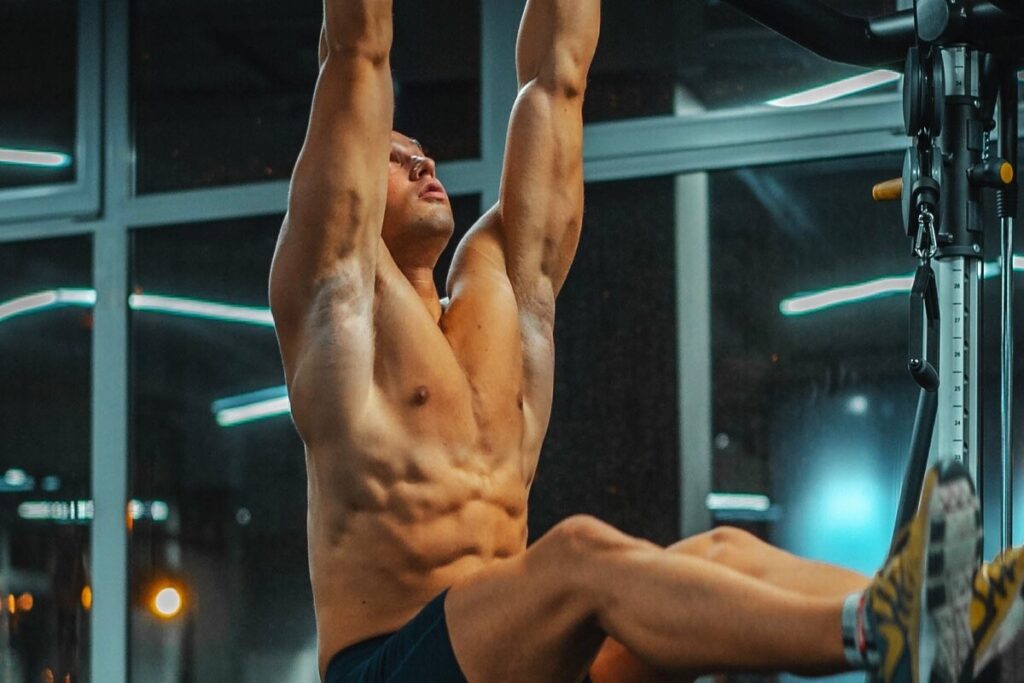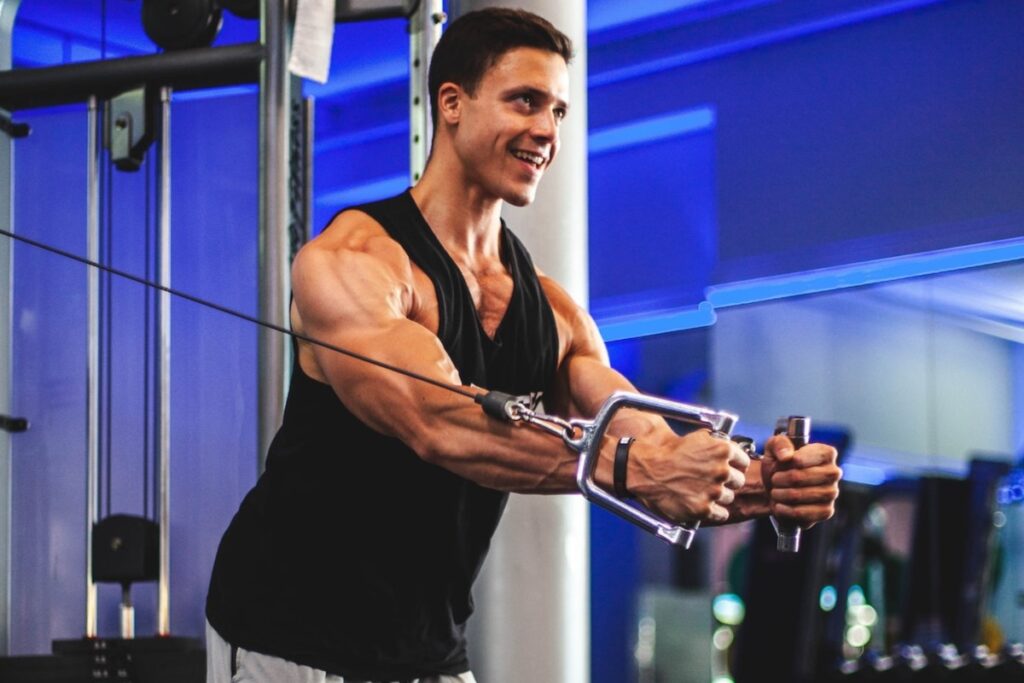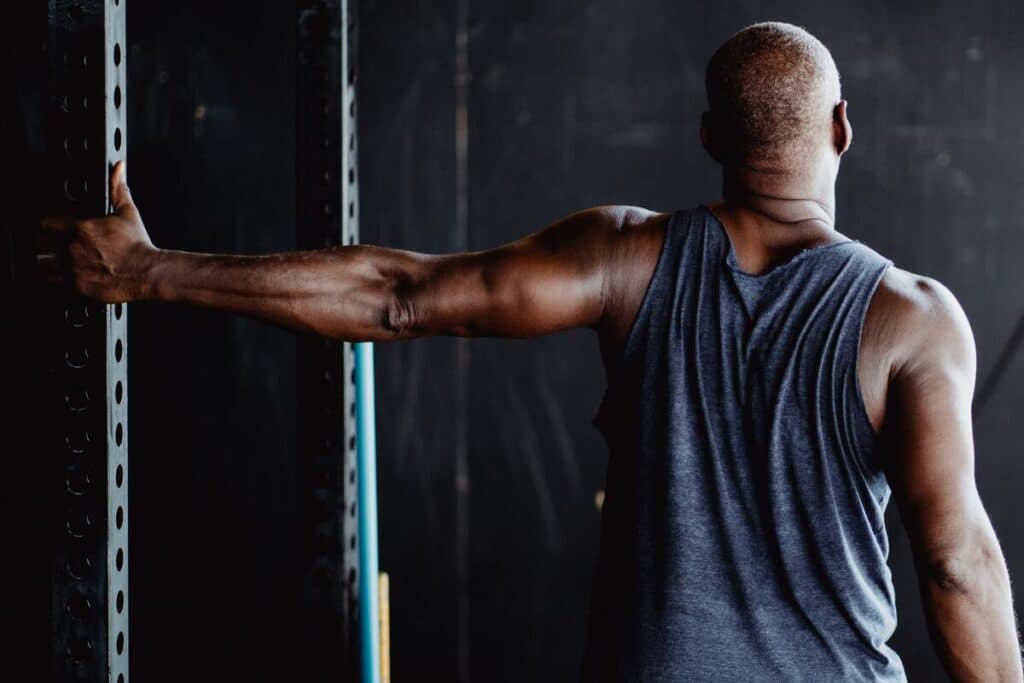
While the term “core workouts for men” may often be associated with traditional crunches and planks, there’s much more to it than meets the eye. From engaging your abs to improving your posture and enhancing your sports performance, core workouts are an essential component of any well-rounded fitness routine.
In this article
In this article, we will explore the key core exercises for men that can help you achieve your fitness goals, the benefits of these exercises, and nutrition tips for supporting core workouts. Ready to transform your core? Let’s dive in and explore the best core workouts for men!
Top 10 Best Core Exercises for Men
A strong core is essential for overall fitness, and the abdominal muscles are a key component of a strong core. Below are the best core workouts for men to help strengthen the abs:
1. Ab Wheel Rollout
This exercise involves using an ab wheel to roll forward and backward from a kneeling position, which helps to engage the core muscles.
- Start kneeling on a mat, holding the ab wheel with both hands, palms facing down.
- Slowly roll the ab wheel forward, extending your arms straight in front of you while keeping your core engaged and your back flat.
- Pause briefly at the furthest point you can go without losing control or touching the floor with your body.
- Slowly roll the ab wheel back towards your knees, maintaining control and tension in your abs. Repeat for the desired number of repetitions, keeping your core engaged throughout the exercise.
2. Turkish Get-up
This exercise is known for improving stability, mobility, balance, and strength. It involves lying down and holding a kettlebell just above the right shoulder, then performing a series of movements to stand up while holding the kettlebell.
- Start by lying on your back on a mat with a kettlebell or dumbbell held with one hand, arm extended towards the ceiling.
- Bend your knee on the same side as the weight, and use your other hand to prop yourself up onto your opposite elbow, keeping your eyes on the weight at all times.
- Push off your opposite hand and lift your hips off the mat, coming up onto your hand and then onto your knee, maintaining a strong core and stable shoulder throughout the movement.
- Stand up from the kneeling position, keeping the weight extended overhead, and then reverse the movement, carefully lowering yourself back down to the starting position with control. Repeat on the other side.
3. Weighted Hanging Leg Raise
This exercise involves hanging from a pull-up bar while raising the legs in a controlled manner, which targets the lower abs and hip flexors.
- Find a sturdy pull-up bar or a set of dip bars, and hang from it with your arms fully extended and your shoulders relaxed.
- Place a dumbbell or weight plate between your feet, ensuring it is secure and won’t slip during the exercise.
- Keeping your legs straight and your core engaged, slowly raise your legs towards the ceiling, lifting them as high as you can while maintaining control and avoiding excessive swinging.
- Lower your legs back down with control to the starting position, and repeat for the desired number of repetitions, maintaining proper form and avoiding swinging or momentum.
4. Kettlebell Dead Bug Pullover
This exercise involves lying on the back with a kettlebell in hand and performing a series of movements that challenge core stability and control.
- Start by lying flat on your back on a mat with your knees bent and feet flat on the floor. Hold a kettlebell with both hands, arms extended towards the ceiling, and engage your core.
- Lower the kettlebell slowly overhead towards the floor, while simultaneously extending your opposite arm and leg towards the floor, keeping your lower back pressed into the mat.
- Pause briefly when your arm and leg are just above the floor, and then slowly return them to the starting position while simultaneously pulling the kettlebell back over your chest, keeping your core engaged and maintaining control throughout the movement.
- Repeat on the other side, alternating sides for the desired number of repetitions, while maintaining proper form and control.
Remember to keep your lower back pressed into the mat and avoid arching or straining your back during the exercise.
5. Pallof Press
This exercise involves using a resistance band or cable machine to perform a pressing motion while standing, which targets the core muscles and challenges stability.
- Sit on a flat bench or sturdy surface with a dumbbell in each hand, resting on your thighs. Plant your feet firmly on the floor, engage your core, and ensure your back is in a neutral position.
- Lift the dumbbells to shoulder height, palms facing forward, and elbows bent at 90 degrees. This is the starting position.
- Press one dumbbell overhead while keeping the other dumbbell at shoulder height. Lower the pressed dumbbell back to the starting position, and then press the other dumbbell overhead, repeating the movement on the opposite side.
- Continue to alternate pressing one dumbbell while keeping the other at shoulder height for the desired number of repetitions, maintaining proper form, and avoiding excessive swinging or arching of the back.

6. High-Tension Plank
This exercise involves starting in a plank position and holding for a longer duration with maximum tension in the core muscles, which helps to improve core stability and endurance.
- Start by getting into a plank position, with your forearms on the ground, elbows positioned directly under your shoulders, and toes tucked under, supporting your body weight.
- Engage your core by pulling your belly button towards your spine and squeezing your glutes. Keep your body in a straight line from head to toe, avoiding any sagging or arching in your back.
- Create tension throughout your body by actively pressing your forearms into the ground, driving your elbows towards your toes, and simultaneously pushing your toes into the ground, as if trying to drag them towards your elbows.
- Hold this high-tension plank position for the desired amount of time, typically starting with 10-15 seconds and gradually increasing the duration as you progress.
7. Leg Raise
This exercise involves lying on the back and raising the legs while keeping them straight, which targets the lower abs and hip flexors.
- Lie flat on your back on a mat or the floor with your arms by your sides and your legs extended.
- Keep your lower back pressed firmly into the floor to engage your core muscles.
- Slowly raise both legs towards the ceiling, keeping them straight and together, until they are perpendicular to the floor or as far as you can comfortably go without straining your lower back.
- Lower your legs back down with control, returning to the starting position, and repeat for the desired number of repetitions.
8. Russian Twist
This exercise involves sitting on the floor with the knees bent and rotating the torso from side to side while holding a weight or medicine ball, which targets the obliques and improves rotational core strength.
- Sit on the floor with your knees bent and your feet flat on the floor, or lift your feet off the ground to increase the difficulty.
- Lean back slightly while keeping your back straight, and engage your core muscles to maintain stability.
- Hold a weight or a medicine ball with both hands in front of your chest, and twist your torso to the right, then to the left, while keeping your feet and hips facing forward.
- Repeat the twisting motion for the desired number of repetitions, making sure to engage your core and maintain proper form throughout the exercise.
9. Bicycle Crunch
This exercise involves lying on the back and performing a twisting motion while alternating between bringing the opposite elbow and knee towards each other, which targets the abs and obliques.
- Lie on your back on a mat with your knees bent, feet flat on the floor, and your hands resting lightly behind your head, elbows wide.
- Lift your head, shoulders, and feet off the ground, engaging your core muscles. This is the starting position.
- Bring your right knee towards your chest while simultaneously twisting your torso to the left, bringing your right elbow towards your left knee. Straighten your right leg, while bringing your left knee towards your chest and twisting your torso to the right, bringing your left elbow towards your right knee.
- Continue alternating sides in a pedaling motion, as if you’re riding a bicycle, while keeping your core engaged and your upper body lifted throughout the exercise.
10. Reverse Crunch
This exercise involves lying on the back and curling the hips towards the chest, which targets the lower abs.
- Lie on your back on a mat with your knees bent, feet flat on the floor, and your hands resting by your sides.
- Engage your core muscles and lift your feet off the floor, bending your knees to 90 degrees, so your shins are parallel to the ground. This is the starting position.
- Curl your knees towards your chest, lifting your hips off the ground, and roll your spine off the mat. Exhale as you crunch, focusing on contracting your lower abs.
- Slowly lower your hips and roll your spine back down to the starting position, inhaling as you do so.
What are the benefits of doing core exercises?
Core exercises are highly beneficial as they help improve stability, balance, and overall fitness level. A strong core, which includes the muscles in the abdomen, lower back, and pelvis, is essential for performing various physical activities and sports. Some of the benefits of doing core exercises for men include:
1. Improved stability
Core exercises train the muscles in the core to work in harmony, leading to better stability. This is crucial for maintaining balance and steadiness, whether on the playing field or during regular activities.
2. Enhanced performance in sports
Most sports and physical activities require a strong core for optimal performance. Core exercises can help men develop a stable core, which can improve their performance in sports activities such as running, weightlifting, and golf, among others.
3. Increased functional fitness
Core exercises can help men improve their functional fitness, which refers to the ability to perform everyday activities with ease and efficiency. A strong core can assist in activities such as bending, lifting, twisting, and reaching, making daily tasks more manageable and reducing the risk of injury.
4. Reduced risk of lower back pain
Core exercises can strengthen the muscles in the lower back, which can help reduce the risk of lower back pain, a common issue among men. A strong core provides support to the spine and helps maintain proper posture, which can alleviate strain on the lower back.

5. Improved posture
Core exercises can help men develop better posture by strengthening the muscles that support the spine. Proper posture not only contributes to a more confident appearance but also helps prevent back pain and other related issues.
6. Enhanced overall fitness
Core exercises engage multiple muscle groups, making them an effective addition to any fitness routine. They can help men build overall strength, endurance, and flexibility, contributing to improved fitness levels and physical performance.
Common mistakes to avoid during core exercises
Core exercises are an important part of a fitness routine, but it’s essential to perform them correctly to avoid potential mistakes that could impact their effectiveness and even lead to injuries. Here are some common mistakes to avoid during core exercises:
1. Generating too much flexion and bending at the core
Exercises like sit-ups and crunches that involve excessive bending and flexion at the core can worsen posture and fail to engage the core muscles properly. To fix this, try exercises that require the core to resist bendings, such as planks, or stability exercises like dead bugs or bird dogs.
2. Failing to engage the core
Not properly engaging the core during exercises can reduce their effectiveness and increase the risk of injuries, particularly in the shoulders and elbows. It’s important to consciously activate and engage the core muscles throughout the entire exercise to maintain stability and control.
3. Not changing the workout over time
Doing the same core exercises repeatedly without progression can limit the effectiveness of the workout. To get stronger and challenge the body, it’s important to gradually increase the difficulty of core exercises by adding weights, changing angles, or incorporating variations.
4. Arching the back
Allowing the back to arch during core exercises, such as planks or leg lowers, can strain the lower back muscles and cause pain. It’s important to maintain proper form and keep the back flat, with the core muscles engaged, to prevent unnecessary strain on the lower back.
To maximize the benefits of core exercises and reduce the risk of injuries, it’s crucial to perform them with proper form, engage the core muscles, progress the workout over time, and avoid any arching or excessive bending at the core.
What are some nutrition tips for supporting core workouts?
When it comes to nutrition tips for supporting core workouts, here are some recommendations:
1. Fuel your workouts with carbohydrates
If you are in good shape and engage in daily, light-intensity workouts, aim to eat about 3 to 5 grams of carbohydrates for every kilogram of body weight, which translates to approximately 200 to 340 grams per day for someone who weighs 150 pounds (68 kilograms). Carbohydrates provide energy that can help support your core workouts and other physical activities.
2. Focus on core-strengthening exercises
Core exercises, which target the muscles in your pelvis, lower back, hips, and stomach, can improve your balance, stability, and overall core strength. Incorporate exercises that engage your core muscles, such as planks, bridges, and rotations, into your workout routine for optimal results.
3. Engage your inner core
When performing core exercises, be mindful of engaging your inner core muscles, including your abdominal muscles and glutes. Creating abdominal pressure, tightening your glutes to lock your hips in place, and contracting your core muscles can help you perform core exercises more effectively and efficiently.
4. Stay hydrated
Proper hydration is essential for overall performance during workouts, including core workouts. Make sure to drink enough water before, during, and after your workouts to stay hydrated and support optimal performance.
5. Consider creatine supplementation
Creatine, a popular supplement among athletes and bodybuilders, may also support core workouts. If you have been using creatine for a while, a daily dosage of 2-5 grams may be sufficient. However, if you are new to creatine supplementation, you may consider a “loading” phase of 20-30 grams per day for 4-5 days followed by a maintenance dose.
As always, it’s important to consult with a qualified healthcare professional or registered dietitian to determine the best nutrition plan for your individual needs and goals.
Frequently Asked Questions (FAQs)
Got more questions about the best core workouts for men? Check out some commonly asked questions about this topic below.
To achieve the best results, it is recommended to incorporate core workouts into your fitness routine at least 2-3 times per week, with proper rest days in between to allow for muscle recovery. However, the frequency and intensity of your core workouts may vary depending on your fitness level, goals, and other factors. It’s always best to consult with a fitness professional to determine the right frequency for your individual needs.
It’s important to consult with a healthcare professional before starting any exercise program, especially if you have existing health conditions, including lower back pain. Core exercises can be modified to accommodate individual needs and limitations. For example, exercises like Pallof Presses and High-Tension Planks can be performed without putting excessive strain on the lower back. Always prioritize safety and seek professional guidance to ensure that you are performing core workouts safely and effectively.
Yes, there are several modifications and progressions you can make to your core workouts. For example, you can increase the difficulty level by adding weights, using stability balls or resistance bands, or trying more advanced variations of exercises like the Hanging Leg Raises, Planks, or Russian Twists. It’s important to gradually progress and challenge yourself, while also ensuring proper form and technique to avoid injuries.
Conclusion
Achieving a strong and toned core is within your reach! By incorporating the best core workouts for men into your fitness routine, you can improve your performance, posture, and overall fitness levels. Don’t forget to share this article with a friend who could benefit from these valuable tips! Check out my full blog for more informative articles on fitness, health, and wellness. Let’s work together towards a stronger, fitter, and healthier you!
